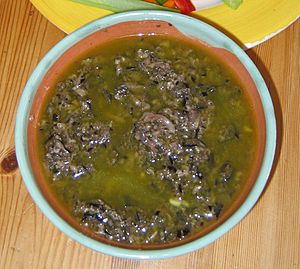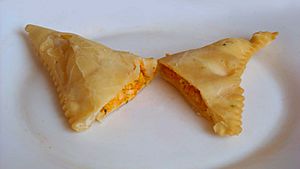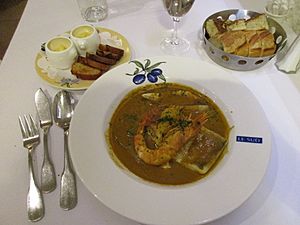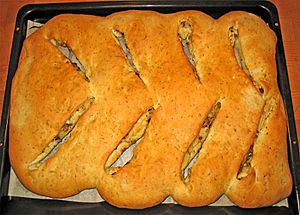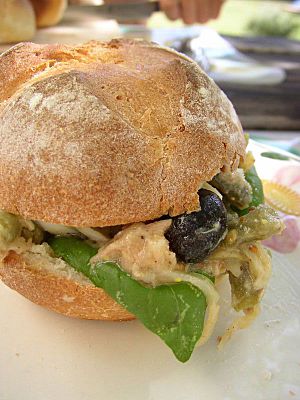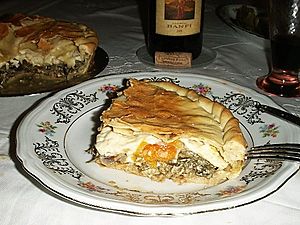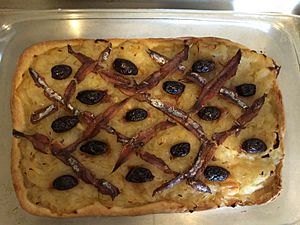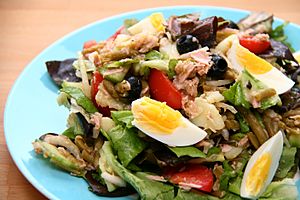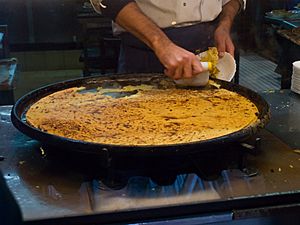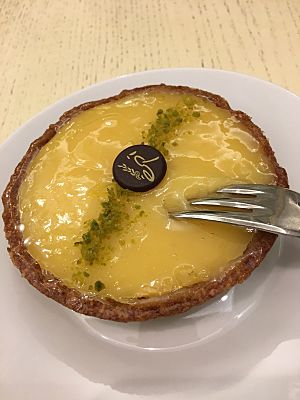Monégasque cuisine facts for kids
Monégasque cuisine is the delicious food from the small country of Monaco. It's a type of Mediterranean cuisine, which means it uses lots of fresh ingredients. The cooking style is influenced by nearby Provence in France, and also by northern Italian and southern French foods. Monaco also has its own special food traditions.
Monégasque food uses a lot of fresh ingredients. You'll find plenty of seafood, vegetables, and olive oil in many dishes.
Since the Monte Carlo casino opened in the mid-1800s, Monégasque cuisine has also become more modern. Some people now connect it with international flavors and fancy Michelin-starred restaurants. But recently, there's been a new interest in finding and keeping Monaco's older, more traditional recipes alive.
Contents
A Look at Monaco's Food History
How Monégasque Food Grew
Monégasque cuisine has changed and grown over many centuries. Around 1000 BC, new ingredients came to Monaco through busy Mediterranean Sea trade routes. These routes connected Monaco with ancient civilizations like Phoenicia, Greece, Rome, and Carthage.
Around 600 BC, the ancient Greeks likely used Monaco as a coastal trading post. They brought grapes and olives to the area. Monaco was already famous for its lemon orchards back then! Later, around 120 BC, the Roman Empire took over. Monaco then supplied the empire with olive oil, lemons, and wine.
Saving Old Recipes
In 1918, a Monégasque expert named Louis Notari (1879–1961) wrote a history book about Monaco. He was worried about losing Monégasque culture, including its food traditions. He wrote about how important olive, lemon, and orange trees were to traditional Monégasque cooking. He also noted that many of Monaco's lemon and orange groves had disappeared because the land was being built on.
Notari especially mentioned fougasse, a type of flatbread. He saw it as a true national food that needed to be saved. He even shared his own recipe for a traditional fougasse. He believed it tasted best with orange blossom, a little brandy, local Monégasque almonds, and a special small apple called Fenouillet-Gris. These ingredients for fougasse came almost entirely from Monaco's local plants and farms.
How Tourism Changed Food
In the 1700s, the food in the French Riviera wasn't very good, according to a writer named Tobias Smollett. In his popular travel book from 1792, he described Monaco as a small, quiet fishing town.
Monaco's first casino, Villa Bellevue, opened in 1854. But at first, there weren't many places for travelers to eat. There was only one inn that served food and drinks.
In 1863, a businessman named François Blanc decided to make Villa Bellevue much better. He opened the Golden Square, which became Monte Carlo's main resort area. It had fancy restaurants and cafés with amazing food. For example, in 1898, the Hôtel de Paris offered a very grand menu. It included many dishes like smoked salmon, lobster soup, roasted lamb, and delicious desserts like crepes and pineapple.
By 1903, restaurants in Monte Carlo were hiring famous chefs from all over Europe. The food became known for being very fancy and international. While Monégasque cuisine grew a lot during this time, some people worried that the older, traditional foods would be forgotten.
Today, Monaco is part of the Provence-Alpes-Côte-d’Azur region in France. This area is well-known for its many Michelin-starred restaurants.
Keeping Food Traditions Alive
In recent years, as food cultures become more worldwide, people have become very interested in keeping Monégasque cuisine special. They want to go back to the older, more traditional ways of cooking that were influenced by Provence. This interest often focuses on areas with strong links to Mediterranean cultural heritage.
One important area is keeping local farming knowledge alive. This includes how to grow and produce key ingredients like fish, wine, cheese, fruits, vegetables, meat, and oils. People also care about the importance of olives and olive-growing traditions. Buying fresh ingredients from local marketplaces is another important tradition they want to keep.
What's in Monégasque Food?
Fruits and Vegetables
Fresh fruit is often eaten on its own or used in desserts. The region has many kinds of fruit. Common fruits include oranges and lemons from Menton, melons from Cavaillon, cherries from Luberon, apricots, grapes, figs, raspberries, bananas, strawberries, and apples.
Many Monégasque dishes use fresh, seasonal local vegetables. These include asparagus in spring, zucchini and eggplant in summer, and pumpkin in fall. Other common vegetables are onions, green peppers, artichokes, tomatoes, fennel, green beans, celery, and potatoes. Vegetables can also be cut raw and served as crudités with a dip. A popular dip is anchovy paste mixed with garlic and olive oil.
Meat and Seafood
Because Monaco is right on the coast, seafood is usually more popular than meat. You can find many kinds of freshly caught fish. These include sea bass, tuna, salmon, red snapper, mullet, anchovy, monkfish, and cod. Other seafood options are octopus, conger eel, prawns, mussels, squid, sea urchins, and shellfish.
The most common meat in Monégasque cooking is lamb. It is often roasted with herbs. Beef is not usually eaten as steaks. It is more often used in slow-cooked stews called daubes. In the past, wild game like rabbits, boars, and birds were popular. But less hunting today means they are used less in Monégasque food.
Other Important Ingredients
Other common ingredients in Monégasque cuisine include nuts like almonds, chestnuts, and walnuts. Herbs like saffron and basil, garlic, anise, honey, butter, and jam are also used. Eggs and orange blossom are important too.
The region is not as famous for cheese as nearby France and Italy. But a popular local cheese is Banon goat cheese. It has a nutty taste and comes in small disks. Each disk is wrapped in chestnut leaves and tied with raffia.
Pasta and rice are also common foods. And olives are a local product that are a very important part of Monégasque cuisine and the Mediterranean diet.
Popular Monégasque Dishes
Common Foods to Try
| Food name | English name | Description |
|---|---|---|
| Anchovy paste | A salty dip made from anchovies, olive oil, and salt. | |
| Stuffed fritters | A fried pastry pocket with a tasty filling. The filling can be zucchini and eggs, or rice and pumpkin. | |
| Beignets de fleurs de courgette | Zucchini flower fritters | Deep-fried zucchini flowers, often served with tomato sauce. |
| Fish stew | A popular seafood dish from the Riviera. It usually has at least four kinds of fish cooked in a fish broth. | |
| Brandaminciun | Salted cod | A traditional salted cod dish. It can be made with garlic, oil, and cream. Often eaten on Christmas Day. |
| Florentines | Chocolate lace cookies | A thin cookie, often a dessert or snack. It usually has almonds and orange peel, with one side covered in chocolate. |
| Focaccia | A small, sweet flatbread, sometimes called a national dish. It can be flavored with oranges, nuts, raisins, anise, apples, and brandy. | |
| Fraises de bois au vin rouge | Wild strawberries | A dessert of wild strawberries served in red wine. |
| Niçoise sandwich | A sandwich with salade niçoise on bread. The bread is dipped in olive oil, vinegar, garlic, and basil. | |
| Easter pie | A layered chard pie, often the main dish on Easter Day. | |
| Provençal onion tart | A dish like pizza, with a topping of onion, olive, anchovy, and herbs. | |
| Rougets à la Niçoise | Nice-styled red mullet | Sautéed red mullet (snapper) cooked with olives, anchovies, capers, and tomatoes. |
| Nice-styled salad | A light salad with olives, tuna, anchovies, and olive oil. | |
| Chickpea crepes | A pancake made from chickpea flour and olive oil. | |
| Soup aux moules | Mussel soup | A soup often served as a starter. It has mussels, herbs, and vermicelli. |
| Soupe de pistou | Pesto soup | A vegetable soup made with basil and olive oil. |
| Stocafi | Stockfish | A fish casserole served with white wine, cognac, and tomatoes. |
| Lemon tart | A buttery, lemon-flavored tart, often served as a dessert. | |
| Tourte de blette | Swiss chard pie | A pastry filled with cheese, often Swiss chard and parmesan. Other fillings can include parsley, eggs, onions, and rice. |
| U Pan de Natale | Christmas loaf | A sweet bread traditionally eaten at Christmastide. It's a round loaf decorated with four walnuts in a cross shape. Olive and orange tree sprigs are placed in the center. |
Food Traditions and Customs
Eating at Home
A baguette is a popular choice for breakfast. Monégasque people might go to a local bakery to get fresh bread for their first meal. Instead of putting the bread in a bag, they often carry it with paper wrapped around the middle. This helps keep it fresh. Breakfast might also include other pastries like croissants and pain au chocolat. Popular drinks are fresh orange juice or coffee.
Traditionally, lunch is the biggest meal of the day. Every Friday, the traditional Monégasque lunch, or dernā, is stocafi.
Monégasque families can buy fresh food for home-cooked meals at the outdoor markets around Monaco.
Eating Out
In a Monégasque restaurant, a typical menu will have several courses. The first course is a starter, or hors d'œvres, usually a soup or a paté. Next comes an entrée, which is often a fish or an omelette dish. The main course is then served. This usually includes lamb, beef, chicken, or game, with vegetables, rice, or potatoes. After the main course, some menus will have a green salad, followed by cheese and dessert. Coffee might also be served, often on its own, not with dessert.
Food for Special Times
It's a tradition for Monégasque people to gather for meals during holidays and other celebrations. Food traditions in Monaco are often linked to religious events.
The blessing of the throat is a custom on St Blaise's Day (February 3rd). People go to church with a small package of dried figs to be blessed. Then, they make a drink with cloves, apple slices, and cinnamon. Drinking this is believed to help cure throat problems.
On Ash Wednesday, the traditional midday lunch is a chickpea soup. It has garlic and herbs like sage and bay leaves for flavor. During Lent, Monégasques also prepare barbagiuans. These fried pastries are now eaten all year round.
Monégasque families traditionally eat together after church on Easter Day. Traditional dishes for this day include roasted kid and a chard pie called pasqualina. Around Easter, street vendors sell Easter pastries called cannestreli. These are decorated with red hard-boiled eggs wrapped in a lattice of pastry to look like woven baskets.
Christmas is usually celebrated with a family meal. Traditionally, before the Christmas meal, families would do the ‘rite of the olive branch.’ The youngest family member dips an olive branch into a glass of wine, and then everyone sips the wine. During the meal, many dishes are eaten. These include brandaminciun (salted cod), cardu (artichoke thistle) in a béchamel sauce, apple fritters, and fougasse.
In the center of the table, the family places u pan de Natale, the Christmas loaf. It stays there until Epiphany. Thirteen traditional desserts are also left on the table with the bread. These desserts are kept full until Epiphany. They might include green and black grapes, three types of nuts, three types of dried fruits, two citrus fruits, two deep-fried desserts, and seasonal pears and apples.
Another Christmas custom is baking mariote e gali for children. These are made from leftover fougasse dough. They are shaped like dolls, similar to gingerbread men. Their eyes and mouth might be made from sugared almonds, with aniseed sprinkled on the doll's body.


